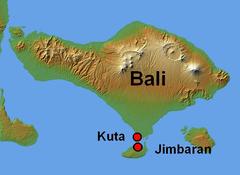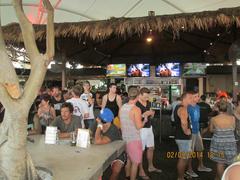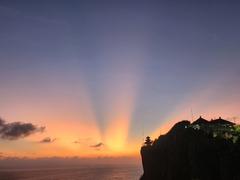
Pura Taman Ayun: Visiting Hours, Tickets, and Comprehensive Guide to a Bali Historical Site
Date: 04/07/2025
Introduction
Pura Taman Ayun, located in Mengwi, Badung Regency, Bali, stands as a testament to the island’s royal heritage, spiritual devotion, and architectural mastery. Constructed between 1632 and 1634 by I Gusti Agung Putu, the first king of the Mengwi Kingdom, the temple served as the principal place of worship for the royal family and a center for honoring deified ancestors and major Hindu deities (budayabali.com; baliluxurytravel.com). “Taman Ayun” translates to “Beautiful Garden Temple in the Water,” and the temple’s serene moat and lush grounds embody the Balinese Tri Hita Karana philosophy, which emphasizes harmony among humanity, nature, and the divine.
Recognized as part of the UNESCO World Heritage Site “Cultural Landscape of Bali Province: the Subak System as a Manifestation of the Tri Hita Karana Philosophy” since 2012, Pura Taman Ayun is notable for its role within Bali’s traditional irrigation system and spiritual ecosystem (unesco.org). Today, it remains an active worship site and a prominent destination for cultural tourism.
Quick Facts
- Location: Mengwi, Badung Regency, Bali
- Construction: 1632–1634 AD by I Gusti Agung Putu
- Architect: Tan Hu Cin Jin (Chinese descent)
- UNESCO Recognition: Since 2012
- Opening Hours: Daily, 8:00 AM – 6:00 PM
- Entrance Fee: ~IDR 20,000–30,000 for adults, IDR 10,000 for children
- Dress Code: Modest attire; sarongs and sashes required (available for rent)
- Main Festival: Anggara Kasih Medangsia piodalan (every 210 days)
Historical and Cultural Significance
Origins and Royal Heritage
Commissioned by the founder of the Mengwi Kingdom, Pura Taman Ayun was designed as the royal pura kawiten, the primary site for ancestral and Hindu worship (baliluxurytravel.com; baliuntold.com). The temple was constructed under the guidance of architect Tan Hu Cin Jin, whose influence brought a blend of Balinese and Chinese architectural motifs (budayabali.com).
Symbolism and Spiritual Philosophy
“Taman Ayun” reflects the temple’s lush gardens, lotus ponds, and water features, which symbolize the mystical ocean encircling Mount Meru, the axis of the cosmos in Hindu belief (discova bali). Its spatial organization follows the Balinese Tri Mandala principle: the Nista Mandala (outer courtyard), Madya Mandala (middle courtyard), and Utama Mandala (inner sanctum), guiding visitors on a symbolic journey from the secular world toward the sacred (nagikubalitour.com; bali.info).
The temple’s irrigation system is integrated into the historic subak, a hallmark of Balinese agricultural and religious life (wikipedia; baliexpat.com).
Living Traditions and Ceremonies
Pura Taman Ayun remains a vibrant religious center, hosting the Anggara Kasih Medangsia piodalan ceremony every 210 days, drawing worshippers from across Bali. The temple’s rituals—centered on offerings to principal Hindu deities and ancestral spirits—illustrate the ongoing importance of traditional Balinese practices (balibelin.com; discova bali).
Architectural Features and Layout
Spatial Organization
The temple complex is laid out on a rectangular plot surrounded by a broad moat, enhancing both its visual appeal and its spiritual symbolism as a boundary between the sacred and the profane (Bali Touristic). The moat is believed to purify and protect the temple, in line with Balinese mythology (Bali.info).
Courtyards
- Outer Courtyard (Nista Mandala): An open public area with manicured lawns and shade trees, ideal for gatherings and festivals.
- Middle Courtyard (Madya Mandala): Accessible by a bridge and ornate gate, this zone contains pavilions (bale) for ceremonies and communal activities, as well as lotus ponds and fountains (Tripoto).
- Inner Courtyard (Utama Mandala): The most sacred area, reserved for priests and rituals, enclosed by walls and containing the primary shrines and meru towers.
Meru Towers and Ornamental Details
Distinctive multi-tiered meru shrines dominate the inner courtyard. There are 27 structures, including meru with 7, 9, and 11 tiers; the tallest symbolizes Mount Mahameru, the mythological home of the gods (Bali.info). These shrines are dedicated to the Hindu trinity and deified ancestors.
The temple is entered via a grand candi bentar (split gate), followed by a series of roofed gates (kori agung) marking increasing sanctity (Tripoto). Walls adorned with reliefs and guardian statues encircle the sacred spaces.
Water Features, Gardens, and Ancillary Structures
The temple’s gardens are meticulously landscaped with frangipani, lotus, bamboo, and tropical plants, while water features underscore the Balinese reverence for water as a purifying force (Bali Touristic). The presence of ponds and fountains also highlights the integration of the subak irrigation system (Nagiku Bali Tour).
Pavilions throughout the temple serve as gathering spaces, performance venues, and shrines to local deities, including those associated with Bali’s volcanoes (Bali.info).
Traditional Materials and Preservation
Pura Taman Ayun’s construction uses red brick, volcanic stone, and hardwoods, with thatched palm fiber roofs. Ongoing renovations (notably in 1937, 1949, 1972, and 1976) have preserved its structural and cultural integrity (budayabali.com).
Visitor Information
Visiting Hours and Entrance Fees
- Daily Hours: 8:00 AM – 6:00 PM
- Entrance Fee: Approximately IDR 20,000–30,000 for adults and IDR 10,000 for children (balitravelhub.com; water-sports-bali.com)
- Best Times: Early morning or late afternoon for cooler weather and optimal photography
Dress Code and Etiquette
- Attire: Sarong and sash required; shoulders and knees must be covered. Rentals available at the entrance (finnsbeachclub.com).
- Behavior: Remain quiet during ceremonies, avoid restricted areas, do not touch offerings, and refrain from stepping over canang sari (offerings).
Accessibility and Facilities
The temple is approximately 18 km from Denpasar and easily reached by car, taxi, or tour. The grounds are mostly flat, but some uneven paths and steps may challenge visitors with mobility limitations. Clean restrooms, parking, and rental sarongs/sashes are provided. Modest refreshment and souvenir stalls are located near the entrance.
Guided Tours and Duration
Guided tours are recommended for deeper cultural insight and can be arranged through local operators. Most visits last 45 minutes to 1.5 hours, with more time needed during festivals or guided experiences.
Photography
Photography is permitted in most areas, but avoid taking pictures of worshippers or during rituals without permission. Some inner sanctums may prohibit photography.
Responsible Tourism Practices
- Environmental Care: Dispose of trash properly, use reusable water bottles, and respect gardens and wildlife.
- Support Local Economy: Hire local guides and purchase souvenirs or refreshments from on-site vendors.
- Cultural Sensitivity: Observe all dress and behavior protocols. Women who are menstruating are traditionally advised not to enter temple grounds.
- Accessibility: Inquire about accessible routes at the entrance if you have mobility needs.
Nearby Attractions
Enhance your itinerary by visiting additional Bali historical sites:
- Taman Burung Bali (Bali Bird Park): Home to a variety of native and exotic birds.
- Sangeh Monkey Forest: A tranquil forest sanctuary for long-tailed macaques.
- Ubud: Bali’s cultural center, famous for art markets, temples, and rice terraces.
- Mengwi Royal Palace: Located nearby and complements the temple’s heritage experience.
Frequently Asked Questions (FAQ)
Q: What are the opening hours for Pura Taman Ayun?
A: Daily, 8:00 AM – 6:00 PM.
Q: How much is the entrance fee?
A: IDR 20,000–30,000 for adults; IDR 10,000 for children.
Q: Is a sarong required?
A: Yes. Sarong and sash are mandatory; rentals are available.
Q: Are guided tours available?
A: Yes. Local guides can be hired on-site or through tour agencies.
Q: What is the best time to visit?
A: Early morning or late afternoon for fewer crowds and better lighting.
Q: Is the temple accessible for people with disabilities?
A: The grounds are mostly flat, but some uneven areas exist. Assistance may be required.
Q: Can I take photos inside?
A: Yes, except in restricted or ceremonial areas.
Visual and Interactive Resources
To enrich your visit, explore high-quality images and virtual tours available on tourism websites. Images of the meru towers, lotus ponds, and ornamental gates, with descriptive alt text such as “Pura Taman Ayun visiting hours” and “Bali historical sites,” help deepen appreciation and accessibility.
Travel Tips for Visiting Pura Taman Ayun
- Dress modestly and carry small cash for tickets and rentals.
- Plan your route to combine with other regional attractions for a fuller day trip.
- Early or late visits offer the most peaceful atmosphere and best photo opportunities.
- Be respectful of worshippers, ceremonies, and local customs at all times.
Conclusion
Pura Taman Ayun is a must-visit Bali historical site that beautifully blends royal legacy, religious significance, and architectural splendor. Its lush gardens, impressive meru towers, and tranquil water features invite visitors into a realm of serenity and spiritual reflection. By respecting cultural protocols and practicing responsible tourism, travelers can enjoy a meaningful, memorable experience while supporting the preservation of Balinese heritage for future generations.
Combine your visit to Pura Taman Ayun with nearby sites such as Tanah Lot or Ubud for an enriching Balinese cultural journey. For further resources, download the Audiala app, explore related posts, and follow us on social media for the latest travel updates and inspiration.
Sources and Further Reading
- budayabali.com
- baliluxurytravel.com
- bali.info
- nagikubalitour.com
- water-sports-bali.com
- baliuntold.com
- unesco.org
- balibelin.com
- balitravelhub.com
- finnsbeachclub.com




